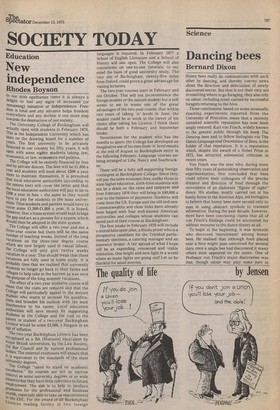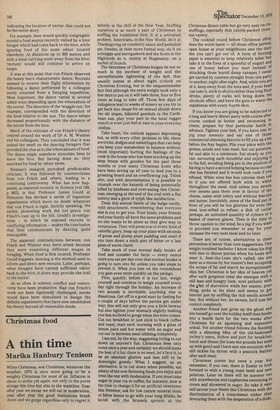Dancing bees
Bernard Dixon
Honey bees really do communicate with each other by dancing, and thereby convey news about the direction and delectation of newly discovered nectar. But that is not their only aid in resolving where to go foraging; they also rely on odour, including scent carried by successful foragers returning to the hive.
Those conclusions, based on some unusually exacting experiments reported from the University of Princeton, mean that a recently tarnished scientific reputation has now been amply restored. Karl von Frisch, widely known to the general public through his book The Dancing bees and to fellow biologists via The Dance Language and Orientation of Bees, is the holder of that reputation. It is a reputation which, despite the award of a Nobel Prize in 1973, has attracted substantial criticism in recent years.
Von Frisch was the mart who, during more than fifty years of painstaking observation and experimentation, first concluded that bees could inform their colleagues of the precise distance and direction of food through the ' movements of an elaborate "figure of eight" dance. His studies, mostly carried out at his family home in the Austrian Alps, led biologists to believe that honey bees were second only to man in using abstract symbols to transmit information. During the past decade, however, there have been convincing claims that all of von Frisch's findings could be accounted for without recourse to the dance theory at all.
To begin at the beginning, it was Aristotle who discoverd 'recruitment' among honey bees. He realised that although food placed near a hive might pass unnoticed for several days, once a single bee had discovered it many others soon appeared on the scene. One of Professor von Frisch's major discoveries was that, though odour may play some part in
indicating the location of nectar, this could not be the entire story.
For example, bees would quickly congregate around a food source recently visited by a lone forager which had come back to the hive, while ignoring food of the same odour located elsewhere. At distances up to 300 metres and with a wind carrying scent away from the hive, 'recruits' would still continue to arrive on target.
It was at this point that von Frisch observed the honey bee's characteristic dance. Recruits seemed to receive their flight information by following a dance performed by a colleague newly returned from a foraging expedition. Most important, the dance varied in several subtle ways depending upon the whereabuts of the nectar. The direction of the 'waggle run,' for example, corresponded with the direction of the food relative to the sun. The dance tempo decreased proportionally with the distance of the nectar from the hive.
Much of the criticism of von Frisch's theory centred around the work of Dr A. M. Wenner and his colleagues. They concluded that it was indeed the smell on the dancing foragers that provided the clue as to the whereabouts of food. The dance might somehow stimulate bees to leave the hive. But having done so. they searched for food by odour alone.
Wenner's research provoked predicatable criticism. It was followed by counterclaims from von Frisch and others, leading to a continuing controversy. What has now happened, as reported recently in Science (vol 189, p 685), is that Professor James Gould at Princeton has devised a series of ingenious experiments which leave no doubt whatever that von Frisch is right. Strictly speaking, the earlier, pioneering work did not prove von Frisch's case up to the hilt. Gould's investigations — in which he exposed recruits to conflicting information — makes the conclusion that bees communicate by dancing quite inescapable.
The apparent contradictions between von Frisch and Wenner may have arisen because they were examining different stages in foraging. When food is first located, Professor Gould suggests, dancing is the method used to inform and direct new recruits. Later, perhaps, when foragers have carried sufficient odour back to the hive, it alone may provide the trail to the nectar.
As so often in science, conflict and controversy have been productive. Had von Frisch's work not been rigorously challenged, noone would have been stimulated to design the definite experiments that have now established his theory beyond all reasonable doubt.


































 Previous page
Previous page